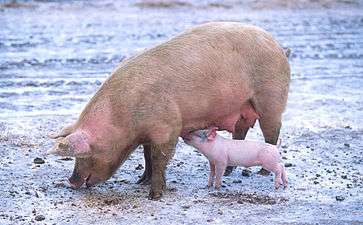Pig's trotters
.jpg)
Pig's trotters, also known as pettitoes,[1] are the feet of pigs. The cuts are used in various dishes around the world, and experienced a resurgence in the late 2000s.[2]
Description


Before sale the trotters are cleaned and typically have the hairs pulled with a hot tank and beaters.[3] They are often used in cooking to make stocks, as they add thickness to gravy, although they are also served often as a normal cut of meat.[3]
Chef Marco Pierre White has long served trotters at his restaurants,[4] based on the original recipe of mentor Pierre Koffmann.[5] In the New York City restaurant Hakata Tonton, 33 of the 39 dishes served contain pig's trotters.[6]
Following the late-2000s financial crisis, there has been a boom in popularity of pig's trotters in the United Kingdom as a revival in cheap meat recipes occurred.[2] In 2008, British supermarket Waitrose reintroduced trotters to its stores,[4] and found that they quickly became popular.[2] In 2009, Pierre Koffmann set up a pop-up restaurant, and found that diners ate an entire month's stock of 500 pig's trotters in less than a week.[2]
Recipes and combinations

- Bean crock/les pais au fou in Jersey, Channel Islands
- Brenebon a Dutch-Indonesian kidney beans soup, traditionally employs pig's trotters as stock base.
- Cappello da prete in Modena, Italy
- 豬腳 Cantonese zyu1 goek3 Mandarin zhu1 jiao3 a traditional Chinese Ingredient most commonly used in the postpartum dish pig trotters with ginger and sweet vinegar 豬腳薑醋, also common among Chinese, specifically Cantonese, diaspora around the world.
- Cotechino in Modena, Italy
- Crubeens in Ireland
- Pezinhos de coentrada (trotters with coriander) in Alentejo, Portugal
- Pied de cochon in Sainte-Menehould, France
- Tebichi in Okinawa, Japan
- Tom tin moo in Laos
- Crispy pata and paksiw na pata or patatim in the Philippines
- Rukyta kiaulės koja in Lithuania
- Zampone in Modena, Italy
- Jokbal in Korea
- Peus de porc in Catalonia
- Souse in Barbados and St. Vincent and the Grenadines
- Spitzbein or Pfoten in German, known as golonka in Polish
- Stelze in Austria
- Körömpörkölt in Hungary
- Svinjske nogice, lit. "pigs' feet" in Serbia, Croatia, Bosnia and Montenegro
The pig's trotters dishes are widespread in Asian and European cuisines. Nevertheless, it is less common in Muslim majority countries as the result of Islamic dietary law of which forbid the consumption of pork. In these countries, the halal cow's trotters are popular instead.
See also
References
- ↑ "Pettitoes Definition". Merriam-Webster Dictionary. Retrieved 29 May 2016.
- 1 2 3 4 Carmichael, Sri (21 October 2009). "Pig's trotters fly off the shelves as customers seek cheap meat cuts". The Evening Standard.
- 1 2 Heath, Adrian (30 October 2009). "A modern bargain: Pig's Trotters". BBC News.
- 1 2 Wallop, Henry (21 September 2008). "Credit crunch sees Bath chaps, ox cheek and pigs trotters return". The Telegraph.
- ↑ Cooke, Rachel (20 June 2010). "Pierre Koffmann: 'Not enough British chefs cook from the heart'". The Guardian.
- ↑ MacDonald Smith, Fiona (3 March 2008). "Pigs' feet: the new superfood". The Telegraph.
External links
| Wikimedia Commons has media related to Pig feet. |
| Wikibooks Cookbook has a recipe/module on |
